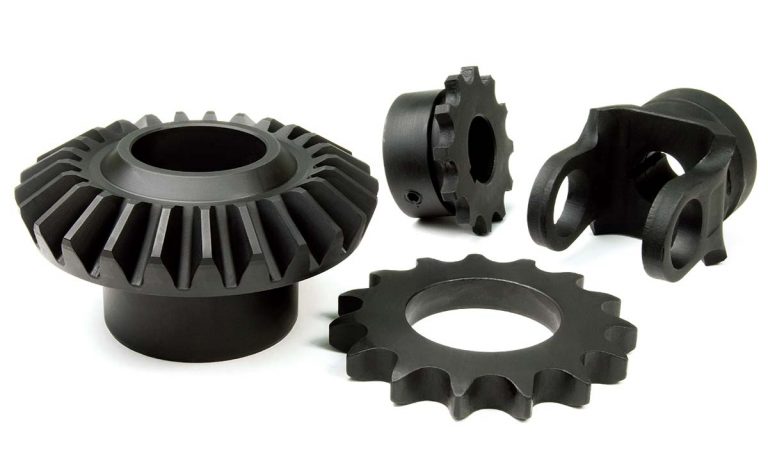
Sprockets, universal joints, and PT components take on a protective and attractive black oxide finish when treated with Tru Temp® mid temperature, non-polluting black oxide.
In-house black oxide finishing for gears is becoming more attractive than outsourcing for one simple reason: it offers more effective control of quality, scheduling and costs.
This article describes the latest trends in black oxide finishing and offers an in-house alternative that enhances quality, speeds shipments and lowers costs.
Due to the hazardous nature of most black oxide processes, manufacturers have traditionally been forced to ship parts to an outside plant for black oxide finishing. In the process, they incur extra costs and turnaround times that make it difficult to satisfy customer shipping demands. In addition, this outsourcing requires higher in-process inventory levels and makes it impossible to have direct control over quality.
By contrast, in-house finishing streamlines workflow and lowers inventory levels, thereby freeing up cash for other uses. An automated in-house black oxide process line allows the manufacturer to machine gear components, black oxide finish quantities the same day, then immediately proceed to assembly or shipping, without delay. It allows the manufacturer to focus on fabricating components (the highest value contribution), then quickly and efficiently handle the black oxide finishing (the lowest value contribution), without disrupting the smooth flow of components through assembly, packaging and shipping.
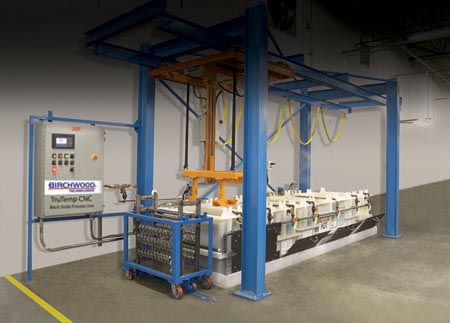
Automated mid temperature black oxide finishing is user proven to be an effective control of quality, scheduling and costs when done in-house.
Black oxide adds value and sales appeal to gear and power transmission components, without altering dimensions or interfering with part assembly or operation. In addition, black oxide finishes are quite durable and offer long-term corrosion resistance in storage or in service. In-house black oxide enhances ISO and "Lean Manufacturing" programs because inventory stays in the plant.
Black oxide, particularly the mid temperature process, is supplied in a variety of pre-engineered systems, complete with operator training, as described below.
With three types of blackening in common use, it's important to weigh the benefits of each before choosing one for an in-house installation.
The first is traditional caustic black oxidizing which utilizes a boiling caustic soda bath operating at 290°F. This system forms a black iron magnetite finish in 20 to 30 minutes. Overall finish quality is usually good, except on cast iron or MIM parts (red coatings are common) or parts with blind holes or recesses (white salt leaching occurs).
The second is room temperature blackening utilizing copper/selenium chemistry. This system operates without heat and forms a black conversion coating in 2 to 5 minutes. These finishes can replace traditional hot black oxide in many applications but the finish is not as durable or as black. Because room temperature blackening requires copper and selenium (both EPA regulated), the process lines require rinse water treatment prior to discharging.
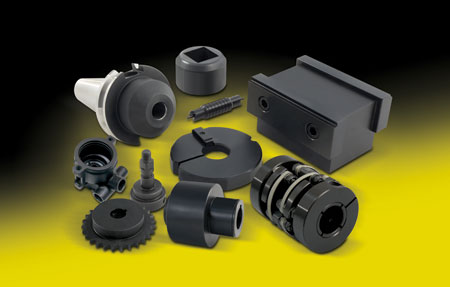
Gear components and similar power transmission components like these can be blackened, assembled and shipped to order, same day with an in-house mid temperature black oxide system.
The third, newest and most desirable black finishing option, is mid temperature black oxide. The process, known as Tru Temp® mid temp black oxide, forms a durable, black magnetite finish with a short 10 minute blackening time. Since the process contains no EPA regulated metals, the rinse waters are non-hazardous and are usually sewerable without waste treatment. The mid temperature eliminates the severe hazards of the 290 degree black oxide, making it easier and far safer to operate. The process also avoids the red coatings and white salt leaching problems commonly seen with conventional black oxide because the overall concentration of caustic soda is 80 percent lower than that of regular black oxide. In short, the Tru Temp process offers a high quality black oxide capability without the severe hazards, thereby making it safe to operate in-house.
All three of the above processes provide good corrosion protection (50-200 hours salt spray resistance) through the use of a rust preventive topcoat that is absorbed by the porous structure of the black finish. Several types of rust preventives are available. All three blackening processes provide dimensional uniformity and stability. Black oxide finishes have a uniform thickness of about 0.000020 inches, making them ideal finishes for precision manufactured components that cannot tolerate the variable thickness of paint or electroplating.
Each of the three black oxide processes has different heat and chemical requirements that must be considered when designing a blackening system.
For today's conscientious manufacturers, the in-house black oxide process itself must be safe to operate, non-polluting and produce highest quality finishes. The mid temperature Tru Temp process does all this and more. The process forms a non-dimensional, deep black finish with long-term corrosion resistance – the ideal surface finish for all types of gear, power transmission and related components.
The finish also prevents galling on thread surfaces and other critical part features. This high level of corrosion protection is important for both part storage and shipment in corrosive atmospheres including ocean shipment.
This mid temperature process operates at just 200°F and uses mild alkaline chemistry that does not embrittle steel components. Manufacturers using this mid temperature process in a CNC system setup report part finishing went from 5 days to same day, so 24 hour order fulfillment became possible, providing an important marketing edge. Operating cost (including chemical and heating cost) averaged just $0.01 to 0.03 per pound of finished work.
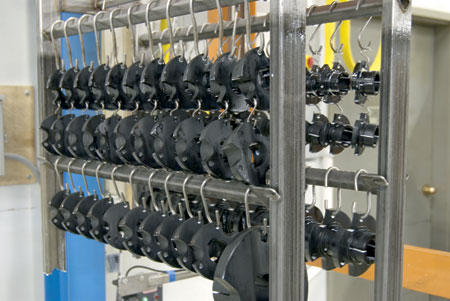
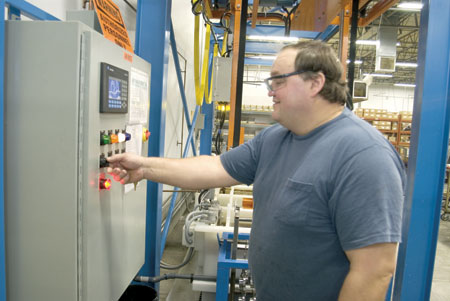
High density part finishing – putting maximum parts through for finishing at one time – is easy with this pre-programmed Tru Temp CNC system. Just load and go.
To maximize the in-house black oxide function for highest quality, fastest turnaround time at the lowest cost, the Tru Temp CNC finishing system was developed. Like virtually all other metalworking equipment which today is CNC controlled (computer numeric control), these CNC black oxide systems are operated by a touch-screen numeric control rather than a live operator. When applied to a black oxide finishing line, CNC control provides similar benefits as other CNC metalworking equipment – fast handling of part loads, consistent quality, elimination of human error and tight control of operating costs.
Ruggedly designed for high volume continuous service, a CNC mid temperature black oxide line usually consists of eight process tanks and ten stations overall. For example, in one installation, the operator of the deburring station loads parts onto the black oxide racks, then wheels them into the pickup station. From there, the hoist automatically processes the load through the various stations of the black oxide line and deposits the finished load in the setdown station 25 minutes later. They are then picked up by the operator in the inspection/assembly station. Configured in this manner, the blackening operation requires zero labor input – all labor is contributed by the adjoining departments. Consequently, total operating costs are extremely low.
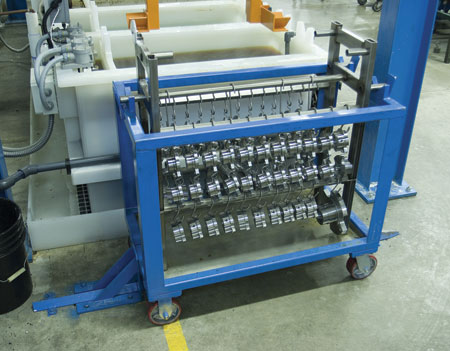
Carts carry unfinished parts to the CNC process line where an automated hoist takes over, moving the rack through the finishing tanks with accurate timing.
A well-designed tank layout can accommodate all the factors listed above, and the supplier of the system can provide guidance. In-house mid temperature black oxide finishing has a proven value to modern manufacturing because it enhances product quality and customer service capabilities while lowering costs.